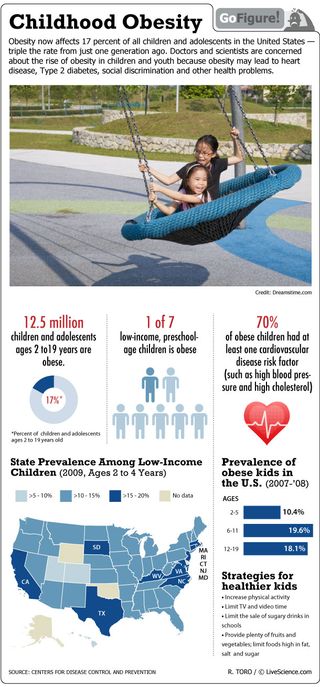Nearly 1 in 5 US Kids Is Obese (Infographic)

With some 17 percent of 2- to 19-year-olds meeting the criteria for obesity, medical professionals have said it's important for society to stay on top of a child's weight.
Even so, according to a 2011 report released by Children's Mercy Hospital in Kansas City, Mo., only about half of parents believe it is "very important" to seek medical care for an overweight child.
"It's not just a cosmetic issue," said Sarah Hampl, the medical director of Weight Management Services at Children's Mercy Hospital & Clinics in Kansas City, Mo., when the report was released in August. "There are medical and psychological complications that are occurring in these kids, and with increasing frequency into their adult years."
Perhaps the associated mental and physical health issues are not as explicitly tied to obesity as they are with other health problems. In fact, the Mercy Hospital survey showed that 81 percent of participants said it would be very important to take a child to the doctor if the child had diabetes symptoms, and 80 percent said the same of asthma.
"With obesity, you don't see what's going on inside the child's body. You don't see the high blood pressure, you don't see the high lipids, you don't see the prediabetes conditions, so that may be a reason that parents don't recognize it as needing more immediate medical attentio," Hampl said.
Parents and nonparents surveyed agreed that parents play the largest role in preventing childhood obesity. However, another survey, this one by Pew Research Center for the People & the Press released in March 2011, suggests Americans don't think parents should bear the sole responsibility in this fight. In fact, results showed that 57 percent of Americans say the government should play a significant role in reducing childhood obesity, while 39 percent say it should not.
Whether or not one group or another plays a more dominant role, preventing a bulging waistline in kids may start at home. A study published in 2010 suggested three simple steps may help prevent obesity in kids: having family dinners, getting enough sleep and limiting weekday TV time. To get the needed exercise, perhaps a pet dog is in order, as researchers have found kids with family dogs were more active than those without a fluffy pet.
Sign up for the Live Science daily newsletter now
Get the world’s most fascinating discoveries delivered straight to your inbox.

